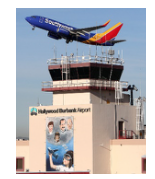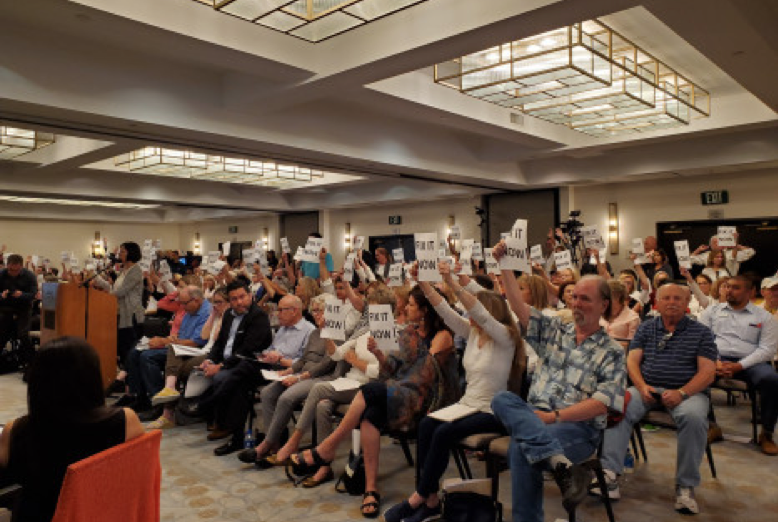CommentsPERSPECTIVE--The “final” Burbank Airport Noise Task Force hearing was held over two nights, May 6th and 7th, via Zoom.
The extra night was necessary due to the influx of over 400 public comments dealing with 19 recommendations compiled by the facilitator, Harris Miller, Miller and Hanson (HMMH). However, even with the extra night, only about half were read; the other half were not recorded to media of any type. I made a Freedom of Information Act request and received a complete transcript.
The nineteen recommendations were based on input received from the individual panel members and from formal presentations made over the course of the six prior meetings.
It seemed ironic that the meetings occurred in the midst of the Coronavirus shutdown. The resultant 95% plunge in air traffic has resulted in the quietest skies over the Valley in generations. Despite a few steady weeks of peace and tranquility, there were still a few comments from hillside residents stating that the noise continued to disturb them. They must have mistaken the Murder Hornets for planes.
The second meeting was devoted to a discussion of each recommendation, then followed by a vote.
The division between the North and South Valleys was apparent from the public comments, with the South Valley communities favoring recommendations directing aircraft departures to head north of the 101, and the North Valley communities in favor of keeping the current paths in place. The current paths disperse the flights equitably over a broad area, ranging from the hillsides along Mulholland Drive, to beyond the 101.
For additional background, please read the several articles on this subject I previously wrote for CitywatchLA.
The first two recommendations on HMMH’s list were the most important. The result was a split decision.
Recommendation 1 called for an immediate restoration of flight departures to 2007 paths. It passed. By itself, it would have shifted the flight paths to the north.
However, Recommendation 2, which called for departures to turn north along the 101, was defeated. Had it passed, it would have been devastating to Valley Village, Valley Glen, and other northern neighborhoods. The defeat of this recommendation should send a message to the FAA: that there is a limit to restoring departures to those used in 2007.
Interesting that Councilmember Paul Koretz voted in favor of it. Only minutes before he claimed he was against concentrating flight paths anywhere. Typical of him to speak from both sides of his mouth. Clearly, not a trait you would want in a candidate for City Controller.
 Councilmember Paul Krekorian managed to muddy the waters by introducing a substitute motion for Recommendation 2 which called for the FAA to consider moving waypoints farther north from the hillsides. Such a move, if implemented, would tend to push the turning points for departures farther north. This was an obvious play to not offend his base in Studio City at the cost of alienating his district’s neighborhoods in the north. It’s called following the money.
Councilmember Paul Krekorian managed to muddy the waters by introducing a substitute motion for Recommendation 2 which called for the FAA to consider moving waypoints farther north from the hillsides. Such a move, if implemented, would tend to push the turning points for departures farther north. This was an obvious play to not offend his base in Studio City at the cost of alienating his district’s neighborhoods in the north. It’s called following the money.
His motion was not on the agenda and may amount to a Brown Act violation.
He later complained that some of his written detailed points were not in the text of the consolidated recommendations prepared by HMMH. HMMH distributed its list of recommendations to the task force on March 31st. He had plenty of time to reconcile any omissions. Waiting as he did to the final meeting was irresponsible and disrespectful to his colleagues and the public; the latter was denied the opportunity to comment.
Krekorian made two similar requests after the final recommendation on the agenda (#19) was voted on. Once again, he had since March 31st to make these requests. Perhaps he thought the other panel members would be too tired to discuss them at that point, so he sandbagged them for over a month.
One of these two tardy recommendations concerned the use of Runway 33 for landings. This runway is used when Santa Ana winds are blowing. According to Patrick Lammerding, the airport’s representative on the task force, Santa Anas affect only 5% of the landings. The rest follow a path that takes the arriving planes over Sherman Way and Roscoe to runway 8. Krekorian was concerned that the hillside residents were disturbed by these minor exceptions.
The motion died. Instead, a previous recommendation would cover it as part of an overall study approved earlier. But Krekorian’s stance reinforced his bias in favor of Studio City, where his home is located.
Perhaps the most pertinent remark of the night came from Marcos Sanchez, who represented Councilmember Nury Martinez. A recommendation called for more takeoffs to the north from Runway 15.
Mr. Sanchez chided the task force for assigning the North Valley only one representative.
Councilmember Martinez’ written input summed up the inequality:
“We strongly oppose any proposal that would send additional departures northbound from Burbank-Hollywood Airport. These routes would take place over the some of the most environmentally contaminated communities in the state. This is not simply a matter of sharing airport noise but would layer on an additional environmental hazard onto a community that already suffers from negative health and other ill effects from landfills, quarries, freeways and industrial uses.”
If only Mr. Krekorian shared the same empathy for his CD2 constituents in the North Valley.
Throughout the presentations in the prior six public meetings, we heard about how school children and residents in the hills were victims of noise. Until Valley Village made its presentation, it was as if no one in South Valley was aware that there were many thousands of school children, elderly in nursing homes, hospitals, and more density north of the 101.
As the senior elected official on the panel, Krekorian could have steered the task force toward advising the FAA to develop the best possible plan to disperse flights within the parameters of safety. Instead, his focus was on exempting certain communities along the hillsides from bearing a fair burden of the noise and pollution.
He was a cheerleader for South Valley advocacy groups.
When money talks, Krekorian listens.
In the end, the FAA will make the decisions whether to even consider any of the recommendations. The agency will have to weigh all the public’s input, not just those advocacy groups with an oversized sense of entitlement.
(Paul Hatfield is a CPA and former President of the Valley Village Homeowners Association. He blogs at Village to Village and contributes to CityWatch. The views presented are those of Mr. Hatfield and his alone and do not represent the opinions of Valley Village Homeowners Association or CityWatch. He can be reached at: [email protected].)
-cw
















